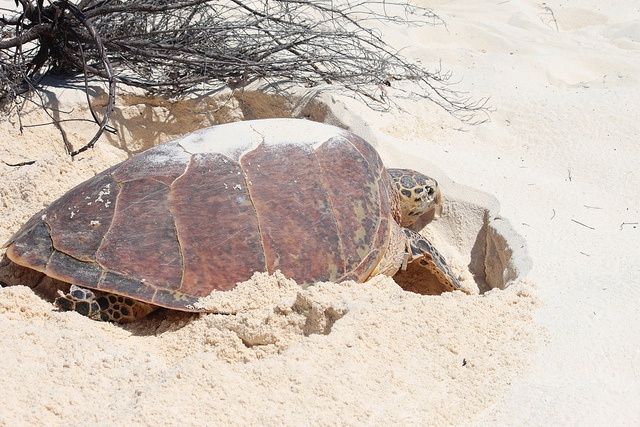Hawksbill turtles find Seychelles safe to lay eggs during the day

Photo of Hawksbill turtle taken on December 9, 2010. (Gerwin Sturm/Flickr) Photo License: (CC BY-SA 2.0)
(Seychelles News Agency) - The Seychelles archipelago is one of two places in the world that hawksbill turtles find safe enough to lay eggs in broad daylight, says a local expert.
Listed as a critically endangered species by the International Union for Conservation of Nature (IUCN), hawksbill turtles lay their eggs in daylight in Seychelles -- and it has nothing to do with the spellbound beauty of the deserted beaches.
Seychellois turtle expert Jeanne Mortimer told SNA that the nesting sites of this species have been exploited so much globally that Seychelles and Chagos islands – 1,500 kilometres east of Seychelles -- are the only two places where they “feel safe enough” to nest in daytime.
Hawksbills turtles grow up to about 114 centimetres in shell length and 68 kilograms in weight, according to National Geographic's website on the hawksbill. They have a strikingly coloured carapace and while young, their carapace, or upper shell, is heart-shaped, and as they mature it elongates. Their tapered heads end in a sharp point resembling a bird’s beak, hence their name.
They have a pair of claws adorning each flipper. Hawksbills are omnivorous and will also eat mollusks, marine algae, crustaceans, sea urchins, fish, and jellyfish, National Geographic says. Their hard shells protect them from many predators, but they still fall prey to large fish, sharks, crocodiles, octopuses, and humans.
Why do hawksbills feel safe to lay their eggs in Seychelles, a group of 115 islands in the western Indian Ocean?
One explanation given by Mortimer is that hawksbills need to nest under the shade of leafy vegetation. Seychelles’ beaches are lined with these types of vegetation, and daylight brings the shade, creating suitable conditions for the turtles.
”That is where the incubation temperature is ideal for producing a balanced sex ratio of males and females,” says Mortimer, noting that the warmer the nest, the more females will be produced.
Mortimer believes that seeing the shade for themselves in daylight helps the hawksbills to know that ‘they have arrived at the right place’ to start nesting.
She refers to a similar study from one of the largest marine protected areas in the world, the Chagos Archipelago. Published last week in Scientific Reports, the paper reveals that hatchling production in sea turtles is influenced by shading and rainfall which helps produce a gender balance nesting.
“Hawksbills are relatively small turtles compared to green turtles. So their nests are shallower and can easily overheat if the eggs are laid in an open sunny area. Much better to lay eggs in the bushes in the shade,” explains Mortimer.
She says that the western Indian Ocean is the only region in the world where this occurs.
“Most hawksbill populations on the East African coast have been completely destroyed. A relatively small number of hawksbills nest in the French islands,” Mortimer said.
In other regions, such as the Persian Gulf, Mortimer says hawksbills nest about 50 percent in the daytime and 50 percent at night.
“Everywhere else in the world they nest primarily at night, throughout the Pacific Ocean, in the Caribbean and in the Atlantic Ocean.”
Seychelles provides feeding grounds for five species of marine turtles but the islands are nesting grounds for only two species - the hawksbill and green turtles.





